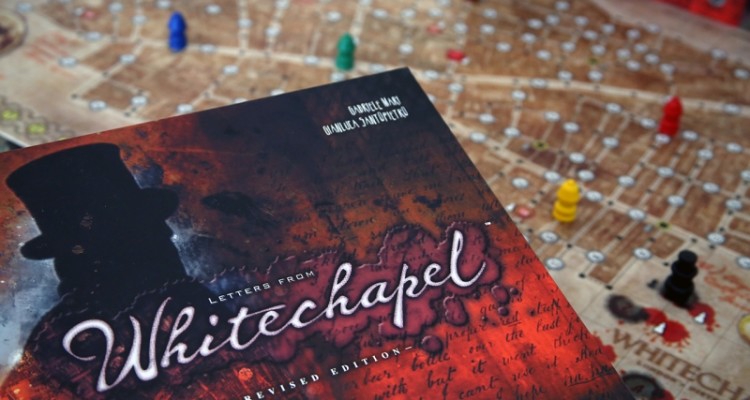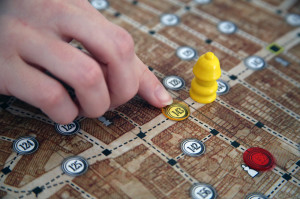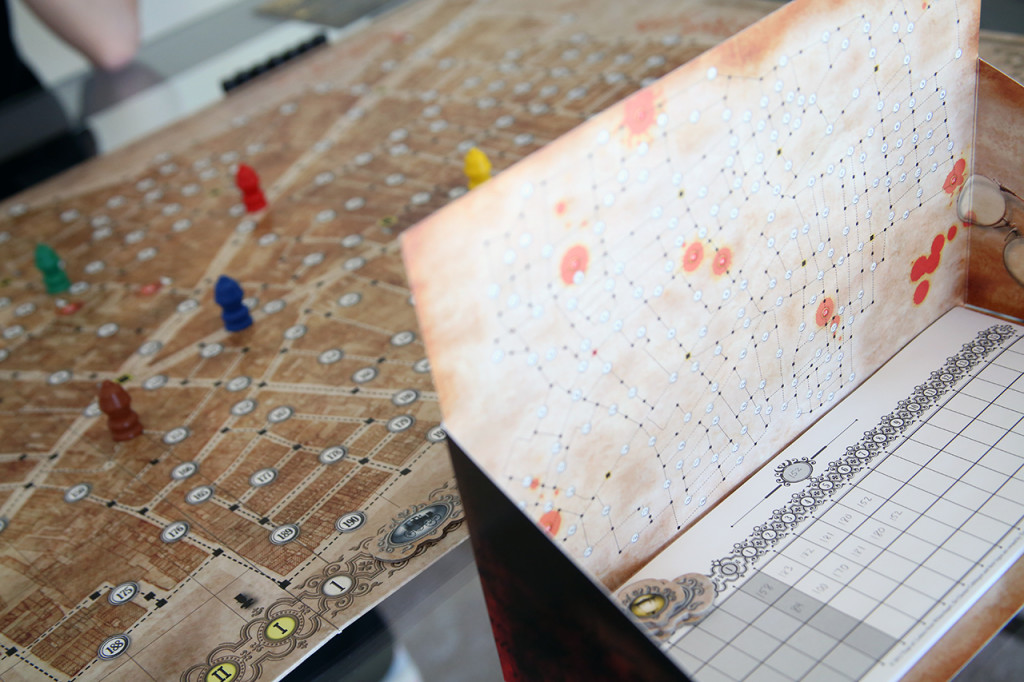The year is 1888. Poverty, prostitution, and murder are plentiful in the Whitechapel district of London. This is the scene of the infamous and mysterious Jack the Ripper. Will you take on the role of the police and help rid the city of this monster? Or, will you step into the shoes of the serial killer and try to escape through the shadows and back to your hideout after taking your victims?
DESIGN
Letters from Whitechapel is a 2-6 player game of cat and mouse. Players will attempt to outwit their opponent—one player will take on the role of Jack the Ripper, while the other player(s) take charge as London’s finest patrolling the streets in an attempt to catch a murderer. The game’s mechanic, when stripped down, is fairly straightforward. Jack will choose a Wretched to kill and swiftly flee the Crime Scene, while the Police seek to close in on his whereabouts before he can return to his hideout.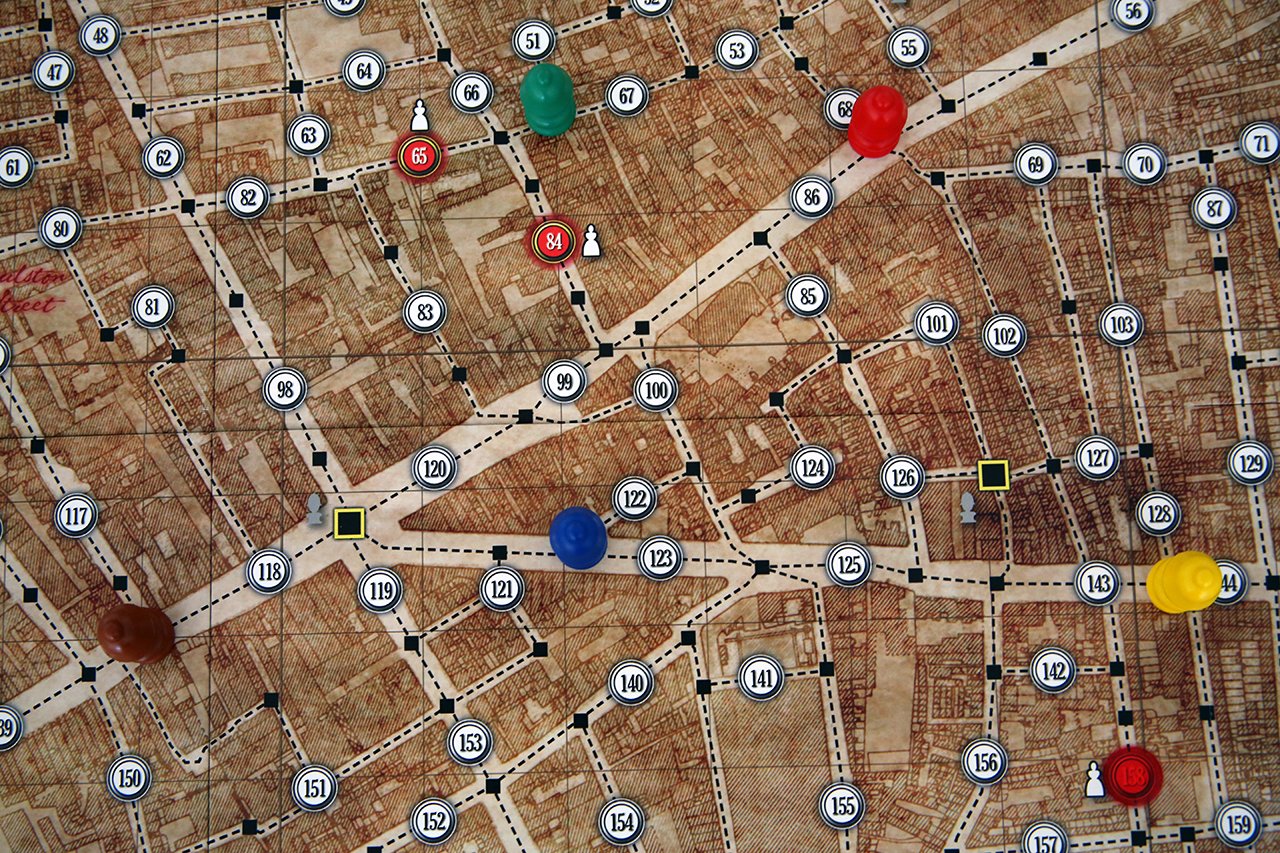
Much to Jack’s delight, the creators have designed quite a large map for him to make his kills and turn tail through the streets. The game board, which aesthetically takes on the look of an old weathered map of London, is peppered with nearly 200 numbered spaces across dozens of streets and alleyways. There are two trackers at the bottom—one to mark which night, or round, and the other to track how many moves Jack has left to escape to his hideout. Thematic details appear around the board, including eyeglasses, blood spatters, and handwritten names of Jack’s victims, to add to the realistic feel of the board.
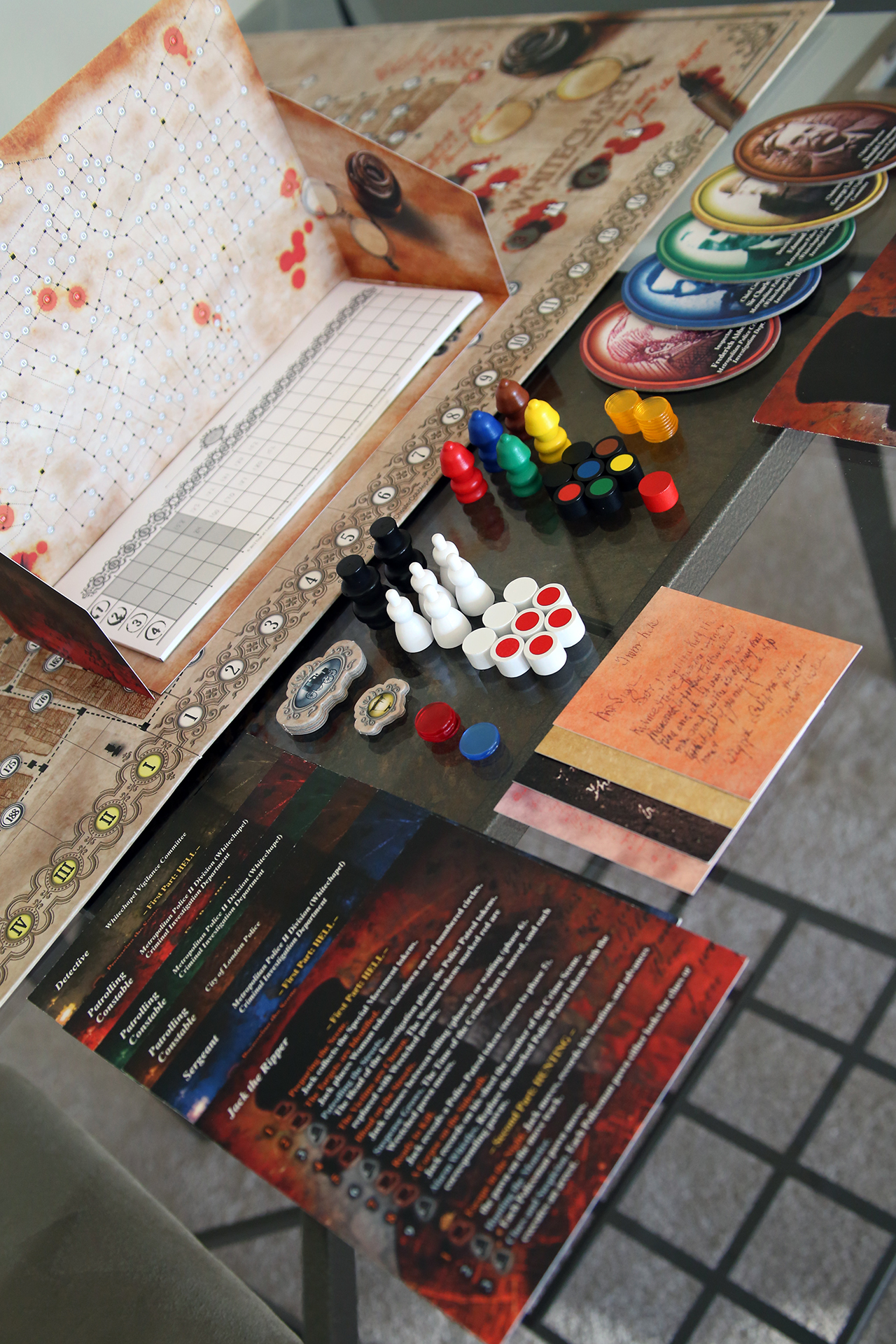 As far as components, the game pawns are all made of wood and designed to simplistically resemble each role (5 Police, 5 Wretched, and 2 Jack). The Jack pawns are a personal favorite because he is sporting a black top hat and looks quite dapper. Additionally, colored, transparent markers are included for a scenario where the police find a clue indicating a place Jack is known to have been.
As far as components, the game pawns are all made of wood and designed to simplistically resemble each role (5 Police, 5 Wretched, and 2 Jack). The Jack pawns are a personal favorite because he is sporting a black top hat and looks quite dapper. Additionally, colored, transparent markers are included for a scenario where the police find a clue indicating a place Jack is known to have been.
For the player taking on the role of Jack, a player screen and pad of movement sheets are handy. The screen contains a mini-map, matching that of the game board, which can be useful so your opponent doesn’t watch your eyes move along your potential escape route.
All the components fit in a medium box, which is a bit large considering, but it has to facilitate the big game board so there is some extra space available.
GAMEPLAY
The game is played as a hybrid co-op and deduction/deception game over 4 nights (rounds). Each night, Jack must choose and murder one of the Wretched. The police players work together to find clues and arrest Jack while he tries to make his escape to his secret hideout without being captured.
It’s suggested that the role of Jack be taken by the player who knows best how to play, which can be said for the Head of Investigation (HOI), too. There is a method by which you can randomly choose the HOI, but Letters from Whitechapel can be intimidating to a new player and for the first playthrough, the more experienced should consider taking the helm. That said, those taking over the duties of HOI should maintain a collaborative mindset. Jack, on the other hand, should not…obviously.
To start, Jack receives the player screen, pad, and Special Movement tokens, while all others pick their favorite color Police pawn. (You’re in luck if your favorite color is doo doo brown.) If there are less than 5 Police players, some players will need to control multiple colors – all police pawns are required for gameplay.
On the game board, there are 199 numbered circles. Some of these circles are outlined in red, indicating possible starting locations for the Wretched pawns. Taking this into account, Jack will choose a white numbered circle as their hideout. For the rest of the game, the goal for Jack is to get back to this numbered location. The hideout cannot change from night to night, so Jack must choose wisely!
Each night has 2 parts, with multiple actions taking place within them. The first part, Hell, essentially, boils down to choosing where each policeman will patrol and where the crime scene will be. This is followed by the second part, Hunting. The list of actions is as follows:
First Part: HELL
Preparing the Scene.
Jack collects the Special Movement tokens.
The Targets are Identified.
Jack places Woman Tokens face-down on red numbered circles. (There are 8 Wretched tokens, 5 of which are marked red on the bottom. The remaining 3 are blank for bluffing purposes.)
Patrolling the Streets.
The Head of the Investigation places the Police Patrol tokens. (Similar to the Woman Tokens, 5 are marked on the bottom with corresponding Policemen colors, while 2 of the tokens are blank to throw off your opponent.)
The Victims are Chosen.
The Woman tokens marked red are replaced with Wretched pawns.
Blood on the Streets.
Jack chooses between killing (phase 8) or waiting (phase 6).
Suspense Grows.
The Time of the Crime token is moved and each Wretched pawn moves.
Ready to Kill.
Jack reveals a Police Patrol token (return to phase 5).
A Corpse on the Sidewalk.
Jack records on his sheet the number of the Crime Scene.
Alarm Whistles.
Replace the marked Police Patrol tokens with the corresponding pawns.
Second Part: HUNTING
Escape in the Night.
Jack moves, records his location, and advances the pawn on the move track.
Hunting the Monster.
Each Policeman pawn moves.
Clues and Suspicion.
Each Policeman pawn either looks for clues or executes an arrest.
The hunt (second part, phase 1-3) is repeated until Jack is either arrested, or he makes it safely back to his hideout. If Jack is arrested or does not make it home before the turn tracker runs out, the police win and the game is over. If Jack makes it to his hideout, or isn’t caught, all of the yellow tokens are removed from the board and the next night begins at the first part!
There are several rule changes for the remaining nights to better balance the game. Jack will eventually have to kill 2 Wretched in a night, while the Police can maintain some of their patrol locations to better their chances of closing in for an arrest. There are also variant elements, such as letters to grant Jack the ability to move Police patrols and false clues to assist him. The Policeman are not without some special abilities including the ability to take a third move action and calling for an arrest on all adjacent spaces.
OVERALL EXPERIENCE
Letters from Whitechapel integrates the theme with the mechanics in a way that truly immerses the players in the world of 19th century East London during the terror of Jack the Ripper. As is the case with any cooperative game where upwards of 5 players are involved, the issue of the alpha player can emerge. Letters from White Chapel is no different; especially considering the role of HOI is essentially designed to be the decision maker. The game tries to mitigate the risk of alpha player by rotating the HOI each round.
Playing the role of Jack (which I prefer), the tension begins to build as you narrowly escape the nosy Police asking around town for clues. There are times where you will feel cornered, but the mechanics are so well balanced with Jack traversing a different path than the Police and Special Movement tokens. It’s hard not to smirk when you’ve just outwitted your opponent. That satisfaction can be felt on the other side of the board, too. Steadily closing in on Jack and finally making a successful arrest gives you the pure sense of victory, more so than any punch board coins could.
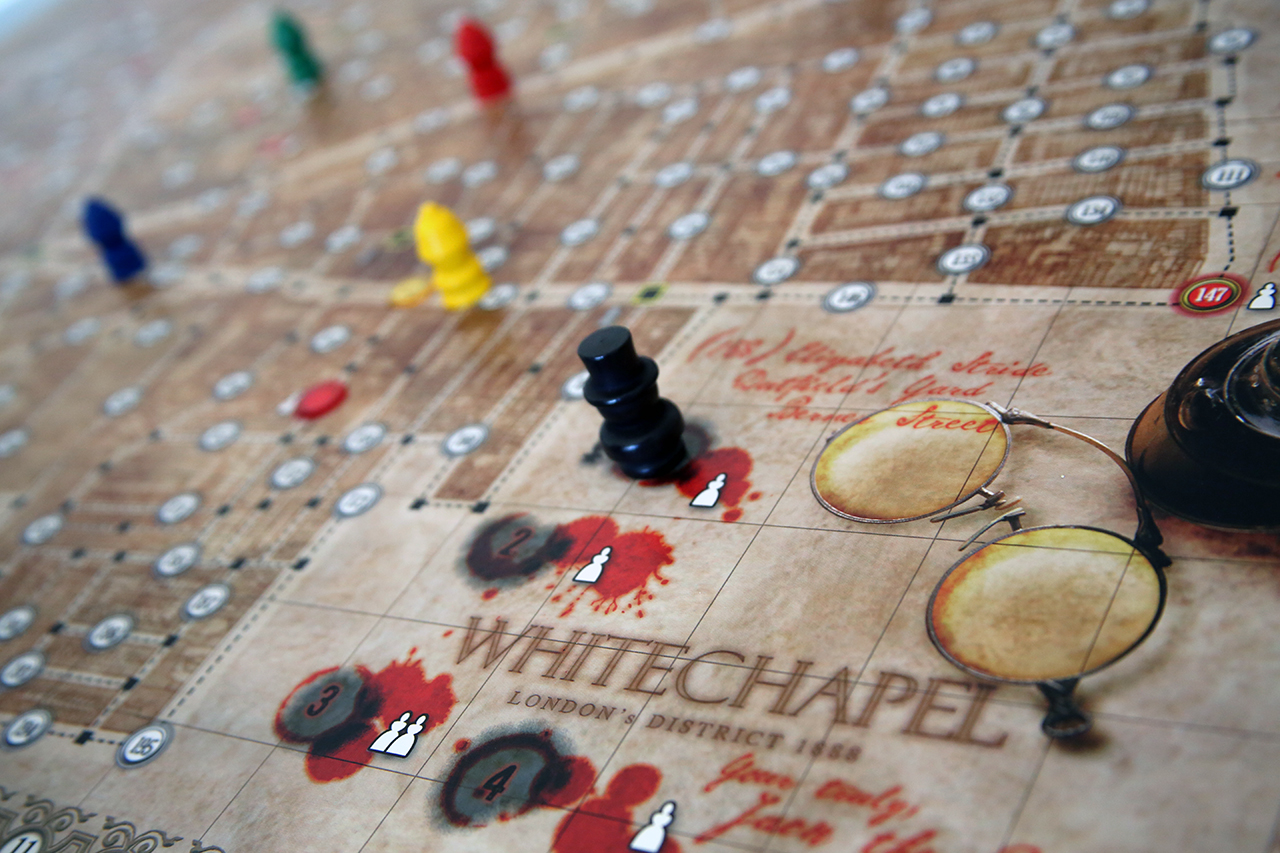 The overall gameplay isn’t terribly complex. Jack moves; the police move; the police search; repeat. The real challenge (and fun) comes from the hidden movement mechanism. It is equal parts probability and guess-and-check, with just a little bluffing mixed in. Generally, Jack has two options: 1) an all-out sprint to his hideout or 2) the most confusing route possible. Both have their advantages and both can be utilized within the same round. Your success depends on your ability to adapt and react to the police players. As the police, you also have options, typically: 1) run straight to the crime scene, pick up the scent and try to head Jack off or 2) spread out, leave an officer back as a safety net, and wait for Jack to cross you. Either way, systematic progression and lots of communication between players is the best way to find Jack before he escapes.
The overall gameplay isn’t terribly complex. Jack moves; the police move; the police search; repeat. The real challenge (and fun) comes from the hidden movement mechanism. It is equal parts probability and guess-and-check, with just a little bluffing mixed in. Generally, Jack has two options: 1) an all-out sprint to his hideout or 2) the most confusing route possible. Both have their advantages and both can be utilized within the same round. Your success depends on your ability to adapt and react to the police players. As the police, you also have options, typically: 1) run straight to the crime scene, pick up the scent and try to head Jack off or 2) spread out, leave an officer back as a safety net, and wait for Jack to cross you. Either way, systematic progression and lots of communication between players is the best way to find Jack before he escapes.
The mix of play options, the asymmetrical player mechanisms and (of course) the diversity of your gaming group will all help to foster a unique gaming experience each time Whitechapel hits the table. At the very least, everyone should give both sides of the investigation a-go because both are very interesting and provide very different experiences. If hidden movement or cooperative play aren’t you thing, this may not be the right one for you. But, if you enjoy logical deduction or, for you shady characters, running from the police, you’ll find a lot here to like.
LEAGUE RULING
Steebin
There was a game I used to play in middle school (Board Gaming club!) which was a variant on the game Clue called The Great Museum Caper. In the game, one player is the thief and is trying to steal paintings and escape the museum while the others are trying to catch him. We all absolutely loved that game. Playing Letters from Whitechapel takes me back to those times.
The theme of the game is what I really love about it. The game mechanics and dual nature of the game can be considered unique. I did, however, make the mistake of bringing this out one night after only one quick read of the rules. Trying to work through the steps of the game with everyone became an absolute nightmare and ended up being a bad experience and people were just bored. Once I got a chance to play it again with my wife, as a 2-player game, we finally got the mechanics and realized that this is probably better as a 2-player game. We have played it a few times together and we have had a lot of fun each time. We have not used some of the optional rules, though, and I would still like to get a full 6-player game under my belt.
Kelly B!
I love this game. I love a lot of things – sometimes I wonder if I love things too much. I have had a fascination with serial killers for a very long time so I was immediately curious about this game. I’ve played it a handful of times, and have played as Jack every time. I really like playing Jack: trying to maneuver myself through the streets of Whitechapel, tricking my police officer opponents into thinking I’m somewhere I’m totally not. I’ve never won as Jack, but I have made it a good chunk of the way through Night 3 without being caught, which I believe is the longest Jack has made it in our group, thank-you-very-much! Even when you get caught, though, it’s still a good time. From playing, I haven’t witnessed much trouble with the policemen dynamic, as far as people appearing to feel as though they can’t contribute, but I can easily see how someone might take control of investigating, especially when playing with new people. I recommend taking your time with learning the rules to this game, but don’t get hung up on the rule book – it’s kind of confusing and the turn description cards that come with the game end up being significantly more helpful. Keep a flexible mindset on your first couple of plays, you might miss things or do things wrong, but as long as everyone is in a cool “hey, we’re getting the hang of it, it’s no biggie” state of mind, catching a serial killer can be great fun!
Buns
I picked up Whitechapel on more of a whim – meaning I didn’t do nearly as much research as usual. There was buzz about the FFG reprint and I had no other hidden movement games in the collection, so I popped it in an order. I’m quite happy I did. I agree that the game is a bit confusing at the start and, like all cooperative games, it could suffer from “Alpha Gamer Syndrome;” but fortunately, the game has hit the table several times and we have consistently had a lot of fun with it. The game is fitted with a ton of high quality components, including a massive board outlining the Whitechapel district. It’s hard not to be simultaneously impressed and taken aback at all of the movement numbers and the thematic design. At first look I thought, “Whoa! This is great!…What the hell does it all mean!?” Fortunately, once you get a hang of the rules, Whitechapel provides a good challenge and is great fun.
Biff
Letters from Whitechapel can be a bit intimidating at first. The first part of the game is essentially the set-up. Luckily, Buns was able to teach me while playing with Kelly B! which made it a much smoother game. After the first part, the hunting–and fun!–begin. Being a big fan of police procedurals, my experience with Letters from Whitechapel was the closest I’ve come to fulfilling my investigative fantasies. In my first playthrough, Kel managed to retreat to her safe house unscathed and I initially felt the carriages were a bit unfair in the first night. It didn’t seem that Buns and I were making adequate progress on our investigation and Jack escaped fairly easily. Come the second round, It began to feel more balanced as we managed to start finding some clues and influence Jack’s movements to the top of the map. We ended up catching Kel in that night and the sense of satisfaction that comes from working toward a single goal and achieving it (in a, sometimes, lengthy game) is unmatched.

